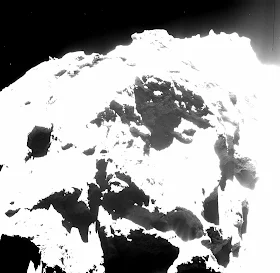Ξαφνικά
ο κομήτης 67P
γέμισε... καταβόθρες. Left: 18 pits have been identified in OSIRIS images of
the comet’s northern hemisphere; the pits are named after the region they are
found in. Middle, top: close-up of the active pit named Seth_01 reveals small
jets emanating from the interior walls of the pit. Right, top: context image
showing fine structure in the comet’s jets as seen from a distance of 28 km
from the comet’s surface on November 22, 2014. Left, bottom: how the pits may
form through sinkhole collapse: (1) heat causes subsurface ices to sublimate
(blue arrows), forming a cavity (2); when the ceiling becomes too weak to
support its own weight, it collapses, creating a deep, circular pit (3, red
arrow); newly exposed material in the pit walls sublimates, accounting for the
observed activity (3, blue arrows). Image credit: ESA / Rosetta / MPS for
OSIRIS Team / UPD / LAM / IAA / SSO / INTA / UPM / DASP / IDA / Jean-Baptiste
Vincent et al.
Μια
νέα πολύ ενδιαφέρουσα ανακάλυψη έκανε το διαστημικό σκάφος Rosetta που ακολουθεί και εξερευνά τον κομήτη 67P. Καθώς ο κομήτης πλησιάζει τον Ήλιο κάνουν
την εμφάνιση τους διάφορα φαινόμενα τα οποία καταγράφει το σκάφος. Η τελευταία
του ανακάλυψη είναι μεγάλοι λάκκοι, σαν καταβόθρες, που έκαναν ξαφνικά την
εμφάνισή τους στην επιφάνεια του κομήτη.
Pits Ma’at 1, 2 and
3 on Comet 67P/Churyumov–Gerasimenko show differences in appearance that may
reflect their history of activity. While pits 1 and 2 are active, no activity
has been observed from pit 3. The young, active pits are particularly steep-sided,
whereas pits without any observed activity are shallower and seem to be filled
with dust. Middle-aged pits tend to exhibit boulders on their floors from
mass-wasting of the sides. The image was taken with the OSIRIS narrow-angle
camera from a distance of 28 km from the comet surface. Credits:
ESA/Rosetta/MPS for OSIRIS Team MPS/UPD/LAM/IAA/SSO/INTA/UPM/DASP/IDA
Πρόκειται
για λάκκους που, σύμφωνα με ερευνητές του Ινστιτούτου Max Planck οι οποίοι μελετούν αυτή την τελευταία
ανακάλυψη του Rosetta,
αν έκαναν την εμφάνιση τους στην Αίγυπτο θα κατάπιναν τις πυραμίδες.
Το
φαινόμενο
Eighteen pits have
been identified in high-resolution OSIRIS images of Comet
67P/Churyumov–Gerasimenko’s northern hemisphere. The pits are named after the
region they are found in, and some of them are active. The context image was
taken on 3 August 2014 by the narrow-angle camera from a distance of 285 km;
the image resolution is 5.3 m/pixel. Image credit: ESA/Rosetta/MPS for OSIRIS
Team MPS/UPD/LAM/IAA/SSO/INTA/UPM/DASP/IDA
Οι
ερευνητές αναφέρουν ότι το έδαφος κάτω από την επιφάνεια του κομήτη υποχωρεί
κατά τόπους, με συνέπεια κάποια στιγμή να καταρρέει η οροφή της κοιλότητας και
να δημιουργούνται έτσι σχεδόν κάθετες κυλινδρικές τρύπες βάθους άνω των 100 μέτρων.
This close-up image
shows the most active pit, known as Seth_01, observed on the surface of comet
67P/Churyumov-Gerasimenko by the Rosetta spacecraft. A new study suggests that
this pit and others like it could be sinkholes, formed by a surface collapse
process similar to the way these features form on Earth. Image credit: Vincent
et al., Nature Publishing Group
Η
μεγαλύτερη τρύπα έχει πλάτος περίπου 200 μέτρα και βάθος άλλα τόσα. Από αυτές
τις καταβόθρες εκρέουν συνεχώς αέρια και σκόνη στο Διάστημα και το πιο
σημαντικό είναι ότι επιτρέπουν στους επιστήμονες να ρίξουν μια ματιά στο
εσωτερικό του κομήτη για πρώτη φορά. Μέχρι στιγμής, έχουν εντοπισθεί 18 τέτοιες
τρύπες.
Graphic explaining
how Comet 67P/Churyumov–Gerasimenko’s pits may form through sinkhole collapse.
The graphic shows a dusty surface layer covering a mixture of dust and ices. 1.
Heat causes subsurface ices to sublimate (blue arrows), forming a cavity (2).
When the ceiling becomes too weak to support its own weight, it collapses,
creating a deep, circular pit (3, red arrow). Newly exposed material in the pit
walls sublimates, accounting for the observed activity (3, blue arrows). Credits:
ESA/Rosetta/J-B Vincent et al (2015).
Οι
ερευνητές εκτιμούν ότι η διάβρωση του εδάφους του κομήτη προέρχεται από την
εξάτμιση των παγωμένων υλικών του καθώς πλησιάζει στον Ήλιο και δέχεται την
έντονη θερμότητά του. Ο κομήτης είναι από τη φύση του πορώδης, οπότε ήδη
διαθέτει κενά στο εσωτερικό του, τα οποία μεγαλώνουν σταδιακά, ώσπου καταρρέουν
τμήματα της επιφάνειάς του.
Η
πορεία
Active pits
detected in the Seth region of Comet 67P/Churyumov¬Gerasimenko can be seen in
the lower right portion of this OSIRIS wide-angle camera image. The contrast of
the image has been deliberately stretched to reveal the details of the
fine-structured jets against the shadow of the pit, which are interpreted as
dusty streams rising from the fractured wall of the pit. The image was acquired
on 20 October 2014 from a distance of 7 km from the surface of the comet.
Credits: ESA/Rosetta/MPS for OSIRIS Team MPS/UPD/LAM/IAA/SSO/INTA/UPM/DASP/IDA
Αυτή
τη στιγμή ο κομήτης 67P
βρίσκεται σε απόσταση περίπου 290 εκατομμυρίων χιλιομέτρων από τη Γη και κατευθύνεται
προς τον Ήλιο με ταχύτητα 32,5 χλμ το δευτερόλεπτο. Στις 13 Αυγούστου θα φθάσει
στο περιήλιό του, δηλαδή στο κοντινότερο σημείο της τροχιάς του από το άστρο
μας, προτού στη συνέχεια πάρει πάλι το δρόμο για τις παγωμένες εσχατιές του
ηλιακού μας συστήματος.
Όπως
ανακοινώθηκε από τον Ευρωπαϊκό Οργανισμό Διαστήματος (ESA), ενώ η αποστολή ήταν προγραμματισμένη να
ολοκληρωθεί όταν ο κομήτης ολοκλήρωνε το κοντινό του πέρασμα από τον Ήλιο,
αποφασίστηκε το Rosetta
να συνεχίσει να συντροφεύει τον κομήτη παρατηρώντας τα φαινόμενα που θα λάβουν
χώρα σε αυτόν όταν θα απομακρύνεται από το μητρικό μας άστρο.
Επιπλέον
η ESA ευελπιστεί ότι όσο
ο κομήτης πλησιάζει τον Ήλιο η διαστημοσυσκευή Philae που βρίσκεται πάνω σε αυτόν θα δεχθεί το
απαραίτητο για τη λειτουργία της ηλιακό φως ώστε να πραγματοποιήσει κάποιες
έρευνες. Τα νέα ευρήματα του Rosetta
και η οι εκτιμήσεις των ερευνητών για αυτά δημοσιεύονται στην επιθεώρηση «Nature».






Δεν υπάρχουν σχόλια:
Δημοσίευση σχολίου